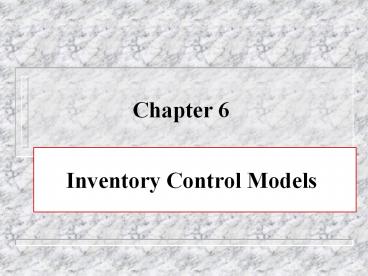Inventory Control Models PowerPoint PPT Presentation
Title: Inventory Control Models
1
Inventory Control Models
- Chapter 6
2
Types of Inventory
3
Uses of Inventory
- As a buffer to decouple
- suppliers and users,
- manufacturers and customers,
- two workstations in a workshop.
4
Costs Related to Inventory
- Carrying (holding) cost
- Ordering cost
- Stockout cost
- Purchase (material) cost
5
Carrying Cost
- Includes
- Capital cost
- Opportunity costs,
- Storage space rental, and labor and facilities
for storage, - Cost of obsolescence and damage,
- Insurance.
- Varies with the amount of inventory.
6
Ordering Cost
- Includes
- Shipping and handling cost,
- Cost of processing orders, such as forms, papers,
labor. - Typically, this cost varies with number of
orders, not with number of units in an order.
7
Stockout Cost
- Includes
- Lost profit,
- Expediting and back ordering expenses,
- Cost of reputation and goodwill
8
Inventory Profile
9
Average Inventory
- Inventory level changes everyday.
- Average inventory is often used to measure
inventory level - Average daily inventory level
10
Some Basic Calculations (1 of 2)
- Dannual demand in units
- Coordering cost per order
- Chcarrying cost per unit per year
- Qorder quantity number of units in an order.
- Number of orders required in a year
11
Some Basic Calculations (2 of 2)
- Total annual holding cost
- Total annual ordering cost
- Total annual inventory cost
12
Economic Order Quantity (EOQ)
- EOQ is the order quantity at which the total
annual cost (annual holding cost annual
ordering cost) is minimized.
13
EOQ Total Costs
- Total annual costs
- annual ordering costs annual holding costs
14
Formula for EOQ
- Let Q be Economical Order Quantity (EOQ)
15
Simco Pump Example (p.197)
- Annual demand 1,000 units
- Ordering cost 10 / order
- Annual holding cost 0.5 / unit
- What is the best order quantity?
16
Simco Pump Example (p.197)
- With order quantity Q200 units,
- (a) How many orders would be made annually?
- (b) What is the total annual ordering cost?
- (c) What is the average daily inventory?
- (d) What is total annual holding cost?
- (e) What is the total annual inventory cost?
17
Simco Pump Example (p.197)
- We have found the EOQ is 200 units per order,
and the associated total annual inventory cost is
100. - If the company orders 250 units each time, what
is total inventory cost then? - If the company orders 100 units each time, what
is total inventory cost then?
18
Purchase Cost, C
- Purchase cost, C, of inventory items is not in
the EOQ formula, since the order quantity Q does
not affect the annual purchase cost, D?C. That
is, C is not relevant in determining the order
quantity. - Sometime, unit carrying cost is a percent, I, of
the purchase cost of the item, i.e., ChIC.
19
Reorder Point
- Reorder point is in terms of number of units on
hand, at which an order should be placed. - Reorder point must be at least the demand during
the lead time (delivery time).
20
Safety Stock
- Safety stock is the extra stock to help in
avoiding stockout, when there exist uncertainties
in demand and lead time.
21
Safety Stock and Uncertainties
22
Formula for Reorder Point
- Reorder Point
- d?L SS
- where
- d average daily demand in units
- L lead time in days
- SS safety stock in units
23
Example (p.201 extended)
- Procomps annual demand is 8,000 units. There are
200 work days per year. So, daily demand is 40
units. - Lead time 3 days
- Safety stock 20 units
- What is the reorder point (ROP)?
24
How Does EOQ Work in Inventory Control?
- For each item k, calculate its economic order
quantity Qk and its reorder point ROPk. - Keep watching the inventory on hand. If the
stock of item k drops to ROPk, order Qk units of
item k.
25
EOQ Assumptions (p.193)
- Demand rate is constant.
- The ordered units are delivered in a single
shipment (instantaneous). - No quantity discount is available
- All demand is satisfied (no shortages)
26
EOQ without Instantaneous Receipt Assumption
(p.201)
- The ordered units arrive piece by piece.
- Application example
- A company's finished good inventory that is
supplied by its production department. - It is called Production Run Model
- The best order quantity is called Optimal
Production Quantity (OPQ).
27
OPQ Formula
- d daily demand in units,
- p daily production capacity in units,
- Cs setup cost (similar to Co)
- D and Ch are defined same as before,
- then
28
Meaning of Q in OPQ
- Q here is still the order quantity (number of
units in an order), but the order is issued to
the production department of the same company. - Therefore, Q can also be understood as the
production batch size.
29
Formulas in Production Run Model
- Maximum Inventory Level
- Average Inventory Level
30
Formulas in Production Run Model
- Total annual ordering cost
- (same as for EOQ)
- Total annual holding cost
- Total annual inventory cost
31
Example of Brown Manuf. (p.203)
- Annual demand 10,000 units
- Setup (ordering) cost 100/order
- Carrying cost 0.50/unit/year
- Daily production rate 80 units
- Daily demand rate 60 units.
- Once a unit is finished, it is counted into the
inventory.
32
To Find EOQ under Quantity Discount (p.206 209)
- Trial-and-error method in general
- May develop a spreadsheet that calculate the
total cost for each possible order quantity.
Then, pick up the order quantity with the lowest
total cost. (See class demonstration)
33
(No Transcript)

